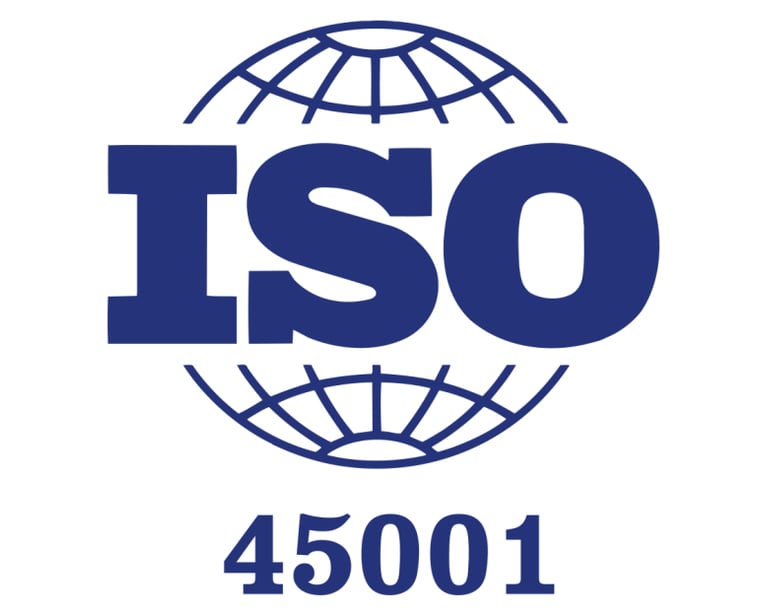
ISO 45001
ISO 45001 is an international standard for occupational health and safety (OH&S) management systems. This standard provides a framework aimed at improving employee health and safety, and reducing workplace accidents and occupational diseases. ISO 45001 specifies requirements for increasing the effectiveness of occupational health and safety management systems and ensuring continual improvement. It also aims to create a safe working environment in workplaces.
ISO 45001 has replaced the former OHSAS 18001 standard and is a globally recognized system. ISO 45001 is a guide for the establishment, implementation, and maintenance of occupational health and safety management systems. It also encourages identifying and taking preventive measures against workplace risks to ensure employee safety.
Key Objectives of ISO 45001
Protect Employee Health and Safety:
To minimize the health and safety risks faced by employees in the workplace.
Reduce Workplace Accidents and Occupational Diseases:
Aims to prevent workplace accidents and occupational diseases.
Ensure Legal Compliance:
Guarantees compliance with relevant laws and regulations and helps fulfill legal responsibilities.
Continual Improvement:
Ensures the continual improvement of occupational health and safety management systems.
Provide Safe Workplace Environment:
Creates a safe environment for employees, using preventive measures, leading to increased productivity.
Key Requirements of ISO 45001
Risk Assessment and Hazard Identification
Workplace health and safety risks must be regularly assessed. Hazard analyses are conducted to minimize risks.
Establishment of an Occupational Health and Safety Policy
The organization must establish occupational health and safety policies and act in accordance with these policies.
Management Commitment and Leadership
Top management must demonstrate a strong commitment to occupational health and safety and provide leadership in these processes.
Employee Participation
Employees must participate in decision-making processes related to occupational health and safety and be able to make suggestions.
Training and Awareness
Employees must be trained and made aware of health and safety issues, and have the necessary knowledge.
Emergency Preparedness and Response
Emergency plans must be created, and preparations must be made for potential emergencies.
Monitoring and Evaluation
The effectiveness of occupational health and safety management systems must be continuously monitored, performance evaluated, and improvements made when necessary.
Documentation and Records
Necessary documents for managing OH&S processes must be prepared, and all relevant records must be kept and made available for audits.


Benefits of ISO 45001
Improved Employee Health and Safety:
ISO 45001 protects employee health and enhances workplace safety by reducing workplace accidents and occupational diseases.
Ensuring Legal Compliance:
Ensures compliance with relevant occupational health and safety laws. This also reduces legal risks.
Increased Workplace Productivity:
A healthy and safe working environment increases employee motivation and productivity.
Reputation and Competitive Advantage:
Having ISO 45001 certification demonstrates the company's commitment to its social responsibilities and provides a competitive advantage in the market.
Risk Reduction:
It is possible to proactively identify potential health and safety risks and prevent them.
Continual Improvement and Performance:
Ensures the continual improvement of occupational health and safety systems and makes the system more efficient.
Increased Employee Engagement:
Employee participation in decision-making processes related to occupational health and safety increases their engagement and reinforces a sense of trust.
Who is ISO 45001 Suitable For?
All Businesses and Organizations: Suitable for all types of businesses, especially large organizations with a large number of employees and companies operating in hazardous industries.
Manufacturing Sector: Particularly beneficial in sectors where workplace accidents are common, such as manufacturing, construction, and heavy industry.
Service Sector: Can also be implemented to protect the health of employees in offices, retail, or the healthcare sector.
Public and Private Organizations: Public sector and large private sector companies can also strengthen their occupational health and safety systems by implementing this standard.
Contact Us to Meet Your ISO Certification Needs and Increase Your Efficiency.
We offer affordable and effective solutions tailored to your needs.
The information presented on this website does not constitute legal advice and is intended for informational purposes only. KompassEurope.com.tr assumes no responsibility for any errors or omissions in the information contained on this website. Any decisions made or actions taken by the reader based on this information are solely at the reader's own risk, and KompassEurope.com.tr shall not be held liable for any legal consequences arising from such decisions or actions. Readers are strongly advised to seek professional legal counsel regarding their specific circumstances and concerns.
© 2025 Kompass Europe. All rights reserved. The contents of this website belong to Kompass Europe and are protected by copyright laws. Copying, publishing, distributing or any commercial use of the information on the website is possible only with written permission. By using this site, you agree to our Terms of Use and Privacy Policy.
